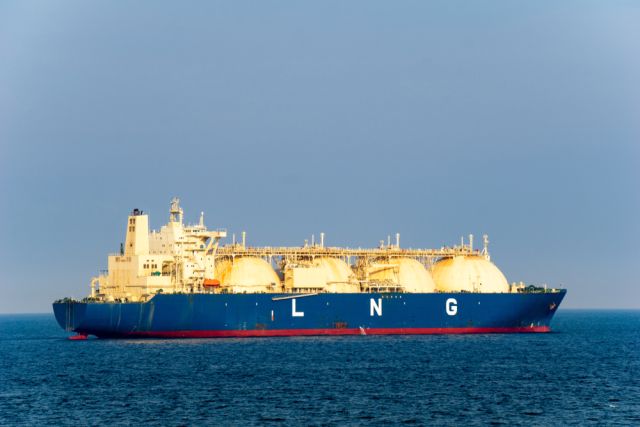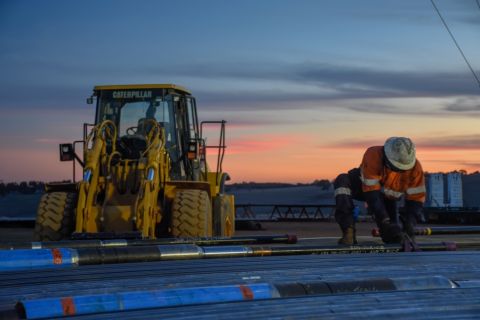
Poten also expects other U.S. LNG projects to add export volumes over the short term, including from Corpus Christi LNG in 2024 and Rio Grande LNG by 2027. (Source: Shutterstock)
Total volumes associated with LNG sales and purchase agreements (SPAs) are down 15% in the first half of 2024 compared to the same six-month period in 2023 —primarily due to U.S. President Joe Biden’s pause on LNG permitting, according to research by Poten & Partners.
“The number of SPAs completed fell significantly in March following the Biden administration's pause,” Ben Gonzalez, Poten’s head of data analytics, said during a July 2 webinar. A U.S. District judge lifted the LNG export pause on July 1.
“Historically, you do see some lower SPAs during the [same six-month periods, specifically in 2020 and 2021] but, nonetheless yes the Biden pause did impact the market significantly,” Gonzalez said.
RELATED
TXOGA Supports Ruling to Pause Biden’s Pause
During the first half of 2024, gas-linked contracts accounted for 36% of all SPAs signed, according to Poten data. Of that percentage, Henry Hub-linked contracts accounted for 36.5%, Japan Korea Marker or JKM (33.5%), followed by the Canadian benchmark AECO (14%) and Waha (11%).
In comparison, in the first half of 2023, gas-linked contracts accounted for nearly 63% of all SPA volumes.
Oil-based contracts accounted for nearly 60% of the SPAs in the first half of 2024; Brent-linked based contracts accounted for nearly all SPA volumes. In the first half of 2023, oil-linked contracts accounted for 35% of the SPAs.
On Jan. 26, Biden formally paused approvals for new LNG export projects. The move was viewed as a key win for environmentalists in the Democratic Party—and a huge source of frustration for gas players. During the pause, the Department of Energy is assessing the role of climate change in the LNG permitting process.
U.S. Energy Secretary Jennifer Granholm said that she expects the review to take a year, until roughly February 2024, well after the election.
In terms of the total number of SPAs signed and linked to U.S. LNG projects, Gonzalez said they were down 73% in the first-half 2024 compared to first-half 2023.
About half of the SPAs signed to date are supporting the construction of new LNG capacity including Delfin LNG, Rio Grande LNG, Texas LNG, Mexico Pacific LNG, Cedar LNG and Ksi Lisims LNG, Gonzalez said.
Despite the decline in both volumes and numbers related to the signed SPAs, Saudi Arabia’s Aramco has signed heads of agreement (HOA) deals with two U.S. projects: NextDecade Corp.’s Rio Grande LNG Train 4 and Sempra's Port Arthur LNG Phase 2.
“We could see for the second half of the year [that] SPAs increase with the U.S. as these HOA deals are aiming to convert to SPAs given certain conditions,” Gonzalez said.
Plaquemines LNG to spearhead 2024 uptick
Poten expects U.S. LNG exports to pick up this year with the start-up of Venture Global’s Plaquemines LNG, which recently started introducing gas into its plant.
“It should be any time now where they should send out their first cargo,” Gonzalez said.
In April, the U.S. Federal Energy Regulatory Commission granted Venture Global permission to start accepting and processing gas into liquefied form for export at its massive Plaquemines LNG export terminal.
The Plaquemines LNG export facility, in Plaquemines Parish on the Mississippi River, is near the Louisiana Gulf Coast. At full capacity, the plant will export up to 20 million tonnes per annum of LNG.
Gonzalez said Poten expects Golden Pass LNG to start up in the second half of 2025 compared to an earlier estimated start date in 2024 owing to delays related to a bankruptcy filing by the company’s lead contractor, Zachry Industrial Inc.
Poten also expects other U.S. LNG projects to add export volumes over the short term, including from Corpus Christi LNG in 2024 and Rio Grande LNG by 2027.
Recommended Reading
Vista to Import New Fracking Set to Boost Production at Argentina's Vaca Muerta
2024-06-11 - Vista Energy will import a new fracking set in the Vaca Muerta and sealed an agreement with SLB for the new equipment.
CNX, Appalachia Peers Defer Completions as NatGas Prices Languish
2024-04-25 - Henry Hub blues: CNX Resources and other Appalachia producers are slashing production and deferring well completions as natural gas spot prices hover near record lows.
US Drillers Add Oil, Gas Rigs for First Time in Four Weeks: Baker Hughes
2024-05-17 - The oil and gas rig count rose by one to 604 in the week to May 17.
Industry Consolidation Reshapes List of Top 100 Private Producers in the Lower 48
2024-06-24 - Public-private M&A brings new players to top slots in private operators list.
Beetaloo Juice: US Shale Explores Down Under
2024-06-28 - Tamboran Resources has put together the largest shale-gas leasehold in Australia’s Beetaloo Basin, with plans for a 1.5+ Bcf/d play. Behind its move now to manufacturing mode are American geologists and E&P-builders, a longtime Australian wildcatter, a U.S. shale-rig operator and a U.S. shale pressure-pumper.




